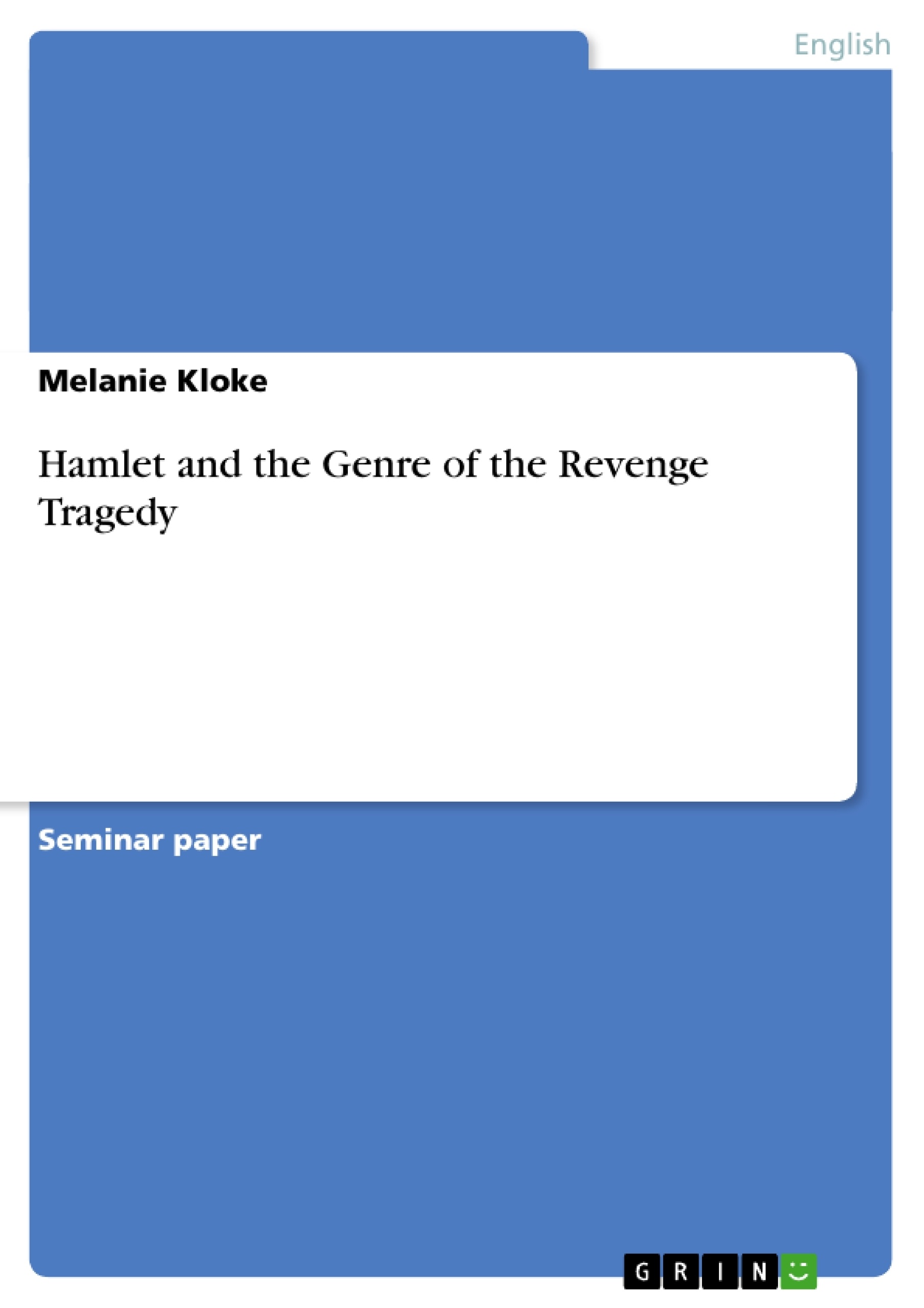In Elizabethan England the genre of the revenge tragedy was very popular. Many plays of this kind by several different playwrights, including William Shakespeare, were written and staged in the 16 th and 17 th centuries. The success of the genre was not only due to it’s bloody, criminal, and therefore exciting action but also to the topicality of revenge at that time. In revenge plays questions were raised which concerned the Elizabethans and which made them reflect on their own situations and attitudes. It was around 1570, that English playwrights took over the concept of the revenge tragedy from foreign authors such as Seneca. 1 However, the genre was so successful and widely spread among the English, that a new Elizabethan revenge tragedy was developed. The Spanish Tragedy by Thomas Kyd, which can be regarded as the prototype of the English revenge drama, constituted a pattern containing the basic elements of a revenge play, which a lot of contemporary authors, such as Shakespeare, are said to have followed. 2 In the following, the success of the Elizabethan revenge play will be examined with respect to the attitude towards vengeance at that time. Furthermore, the relevance of the revenge tragedies for the Elizabethan audience will be taken into consideration. Afterwards, the pattern introduced with Kyd’s The Spanish Tragedy, the Kydian formula 3 , will be depicted before it’s basic constituents will be related to Hamlet, the most famous Shakespearean tragedy, in which revenge is an important motive. [...]
Table of Contents
- Introduction
- Revenge in the Elizabethan World
- Revenge and the Elizabethan Audience
- Influences on Shakespeare's Revenge Plays
- The pattern of Elizabethan Revenge Plays: The Kydian Formula
- The Action in the Kydian Revenge Play
- The Delay
- Play-Within-a-Play
- Characters in the Kydian formula
- The Avenger
- The Villain
- The Ghost
- The Message of the Elizabethan Revenge Tragedy
- The Action in the Kydian Revenge Play
- Hamlet as a Revenge Play
- The Action of Hamlet
- The Delay
- The Play-Within-a-Play
- The Characters
- The Avenger
- The Villain
- The Ghost
- The Message of Hamlet
- The Action of Hamlet
- Conclusion
Objectives and Key Themes
This seminar paper examines the genre of the revenge tragedy in Elizabethan England, focusing on its popularity, themes, and the influence of the Kydian formula on Shakespeare's *Hamlet*. The paper aims to explore the following key themes:- The role of revenge in Elizabethan society and its relationship to the legal system, religion, and morality.
- The appeal of revenge tragedies to Elizabethan audiences, highlighting their connection to contemporary issues and concerns.
- The influence of Thomas Kyd's *The Spanish Tragedy* on the development of the Elizabethan revenge tragedy and the establishment of the Kydian formula.
- The application of the Kydian formula in Shakespeare's *Hamlet* and its significance in shaping the play's plot and character development.
- The overall message of the Elizabethan revenge tragedy, examining the complex moral dilemmas and ethical considerations raised by the genre.
Chapter Summaries
- The Introduction outlines the popularity of revenge tragedies in Elizabethan England and highlights their topicality and relevance to contemporary issues. It also introduces the concept of the Kydian formula, a pattern derived from Thomas Kyd's *The Spanish Tragedy*, that served as a framework for many revenge plays.
- Chapter 2 explores the concept of revenge in Elizabethan society, examining its historical and cultural context. It discusses the conflicting attitudes towards private revenge, highlighting the tension between the legal system, religious morality, and the lingering tradition of blood feuds.
- Chapter 3 examines the appeal of revenge tragedies to Elizabethan audiences. It emphasizes how the plays resonated with contemporary concerns about justice, morality, and the effectiveness of the legal system. The chapter also discusses the audience's moral dilemma in empathizing with the avenger while condemning his actions.
- Chapter 4 explores the influence of the Kydian formula, as established by Thomas Kyd's *The Spanish Tragedy*, on the development of the Elizabethan revenge tragedy. It identifies the key elements of the formula, including the delay, the play-within-a-play, and the recurring characters of the avenger, the villain, and the ghost.
- Chapter 5 delves into the application of the Kydian formula in Shakespeare's *Hamlet*. It analyzes how the play follows the established pattern, focusing on the delay, the play-within-a-play, and the characters of Hamlet, Claudius, and the ghost of Hamlet's father.
Keywords
This seminar paper explores the Elizabethan revenge tragedy, focusing on its historical context, its appeal to audiences, and its influence on Shakespeare's *Hamlet*. Key terms and concepts include: Elizabethan drama, revenge tragedy, the Kydian formula, Thomas Kyd, *The Spanish Tragedy*, William Shakespeare, *Hamlet*, justice, morality, religion, blood feud, legal system, audience engagement, play-within-a-play, avenger, villain, ghost.- Quote paper
- Melanie Kloke (Author), 2006, Hamlet and the Genre of the Revenge Tragedy, Munich, GRIN Verlag, https://www.grin.com/document/66583




